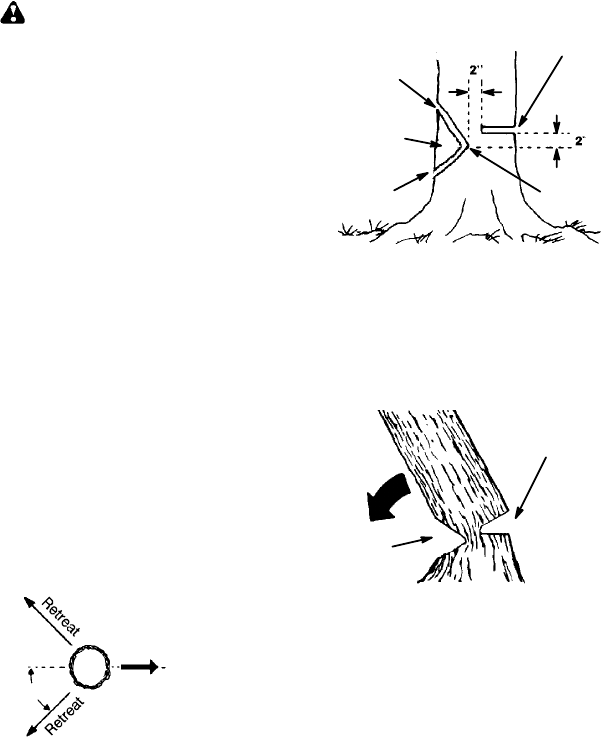
11
S Release the throttle trigger as soon as
the cut is completed, allowing the en-
gine to idle. If you run the saw at full
throttle without a cutting load,unneces-
sary wear can occur to the chain, bar,
and engine.
S Toavoidlosingcontrolwhencut iscom-
plete,donot putpressure onsaw atend
of cut.
S Stop the engine before setting the saw
down after cutting.
TREE FELLING TECHNIQUES
WARNING: Check for broken or
dead branches which can fall while cutting
causing serious injury. Do notcut near build-
ings or electrical wires if you do not know the
direction oftree fall,nor cut atnight since you
will not be ale to see well, nor during bad
weather such as rain, snow, or strong winds,
etc.
S Carefully planyour sawingoperation inad-
vance.
S Clear thework area. Youneed acleararea
all aroundthetree so you can have secure
footing.
S Study the natural conditions that can cause
the tree to fall in a particular direction.
Natural conditions that can cause a tree to
fall in a par ticular direction include:
S The wind direction and speed.
S The lean of the tree. The lean of a tree
might not be apparent due to uneven or
sloping terrain. Use a plum b orlevel to de-
termine the direction of tree lean.
S Weight and branches on one side.
S Surrounding trees and obstacles.
Look for decay and rot. If the trunk is rotted, it
can snap and fall toward the operator . Check
for broken or dead branches which can fall on
you while cutting.
Make sure there i s enough room for the tree t o
fall. Maintain a distance of
2-1/2 tree lengths
from the nearest person or other objects. En-
gine noise can drown out a warning call.
Remove dirt, stones, loose bark, n ails, staples,
and wire from the tree where cuts a re to be
made.
Plan a clear retreat pat hto the rear and diag-
onal to the line of fall.
Direction of Fall
45_
Plan a clear retreat path
FELLING LARGE TREES
(6 inches in diameter or larger)
The not ch method is used to fell large trees.
A notch is cut on theside ofthe treein thede-
sired direction of fall. After a felling cut is
made on the opposite side of tree, the tree
will tend to fall into the notch.
NOTE: If the tree has large buttress roots,
removethem before making the notch. If us-
ing saw to remove buttress roots, keep saw
chain from contacting groundto preventdull-
ing of the chain.
NOTCH CUT AND FELLING THE
TREE
S Make notch cut by cutting the top of the
notch first. Cut through
1/3 of the diameter
ofthetree. Next complete thenotch bycut-
ting the bottom of the notch. See illustra-
tion. Once the notch is cut remove the
notch of wood from the tree.
Notch
First cut
Second cut
Final (felling) cut here. 2 inches
above center of notch.
Hinge
S After removing the cutout of wood, make
the felling cut on the opposite side of the
notch. This is done by making a cut about
two inches higher than the center of the
notch. This will leave enough uncut wood
between the felling cut and the notch to
form a hinge. This hinge will help prevent
the tree f rom falling in the wrong direction.
Opening
of felling
cut
Closing of
notch
Hinge holds tree on stump and helps
control fall
NOTE: Before felling cut is complete, use
wedges to open the cut when necessary to
controlthedirection offall. To avoidkickback
and chain damage, use wood or plastic
wedges, but never steel or iron wedges.
S Bealerttosignsthatthetreeisreadytofall:
cracking sounds, widening of the felling cut,
or movement in the upper branches.
S As tree starts to fall, stop saw, put itdown,
and get away quickly on your planned re-
treat path.
S DO NOT cut down a partially fallen tree
with your saw. Be extremely cautious with
partially fallen trees that may be poorly
supported. When a tree doesn’t fall com-
pletely,setthesaw asideand pu lldownthe
tree with a cable winch, block and tackle,
or tractor.


















